Abandoned places go against the popular saying: “if you build it, they will come”…
If you’ve ever seen the iconic baseball film Field of Dreams, then you know that when Kevin Costner builds a baseball field on his farm, baseball legends actually time travel through his corn fields to play their beloved game.
So what exactly does this have to do with abandoned places around the world?
Much like Costner’s character learns in the film, architects around the world have learned that when it comes to landmarks, sporting venues and even statues, “If you build it, people will come.”
But, what about the places around the world that have since been abandoned?
What about the landmarks, historic sites and ghost towns that have been long forgotten, closed or perhaps never even opened?
From ancient towns and multi-million dollar sports venues to amusement parks and underwater statues, we traveled the world to find 20 of the craziest abandoned places.
What inspired people to settle these towns, build these venues or visit these sites?
Which abandoned places are worth visiting and why? Pack your bags and get ready for an adventure as we start our trip with one of the biggest sporting events in the world!
Abandoned Places #20 – 1984 Winter Olympic Venues (Sarajevo, Yugoslavia)
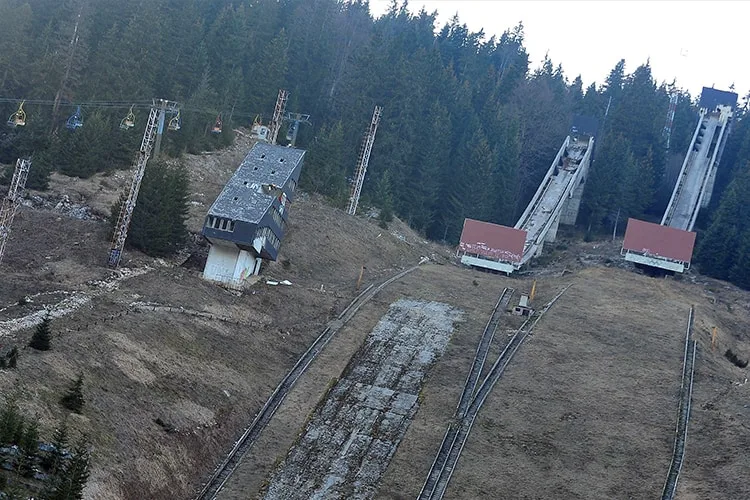
The first Winter Olympics ever held in a Communist state, the first round of voting for the 1984 Winter Olympics left many to believe that Sapporo, Japan would host the games.
The second round of voting, however, proved to be an upset as members voted for Sarajevo, Yugoslavia to host 1,272 athletes and 39 events from February 8th to February 19th, 1984.
Despite the excitement over a successful event, Sarajevo had little use for the newly constructed Olympic venues after the games were over.
In 1987, the Alpine Skiing World Cup used the same venues but by 1991 it was closed completely when the Yugoslav Wars began.
Over the next four years, the venues were destroyed as the bobsled and luge tracks became a field artillery location and the alpine skiing area became a military base.
As for the hockey arena, it suffered so much damage during the war that it crumbled to the ground and took with it any reminder of a happier and more peaceful time.
On the edge of your seat and can’t wait to read more? Or hey, maybe feeling even just a little entertained?
If so we hope you please consider clicking the share and like buttons below.
Thanks so much!
#19 – 2004 Summer Olympics Venues (Athens, Greece)

Better known as Athens 2004, the second abandoned places on our list is yet another Olympic venue.
Traveling from Yugoslavia to Greece, the Olympic Games returned to their birthplace in 2004 when Athens, Greece put $10 billion into constructing new buildings and improving local infrastructures as they prepared to host 10,625 athletes in 301 sporting events from August 13th to August 29th.
Needless to say, the Olympics returning home created a lot of intrigue.
Over a decade later, Athens has little to show for the $10 billion spent in preparation for the games.
Today, the Olympic Sports Complex is completely vacant while the rowing and canoeing center has been emptied leaving only rotting bleachers that still bear the faded Olympic logo.
Not even the track and field venue could escape the test of time as the grass is overgrown much like the weeds that have overtaken the deserted beach volleyball center, leaving little evidence that the games ever returned home.
#18 – Hashima Island/Gunkanjima (Nagasaki, Japan)

When it comes to the craziest abandoned places in the world, what could be better than a deserted island?
A far cry from white sandy beaches, crystal clear waters and umbrella drinks, the island of Gunkanjima is officially known as Hashima Island and is nestled nine miles off the coast of Nagasaki in southern Japan.
First established in 1887, the 16-acre island became popular for its undersea coal mines that served during the industrialization of Japan.
Reaching the height of its population in 1959, the island was abandoned by 1974 after coal supplies ran dry and forced the mine to close leaving around 5,000 residents no other choice but to pack up and leave.
Abandoned now for over 30 years, the island’s iconic concrete structures and sea wall remain untouched except by nature and have since earned the site the official title (in 2015) as a UNESCO World Heritage site recognized for its symbolism of Japan’s labor history and industrialization.
How’s that for a piece of Japanese history?
#17 – Mirny Diamond Mine (Eastern Siberia, Russia)

Diamonds are a girl’s best friend! Once recognized as the first and largest diamond mine in Russia, the Mirny Mine in Eastern Siberia is now the second largest excavated hole in the entire world.
As diamond mining began in 1957, the Siberian climate proved to be incredibly harsh on the workers with seven months of sub-freezing temperatures and brief summer months that turned the ground into mush.
Despite this, miners adjusted their processes and managed to uncover 10 million carats of diamonds per year leaving the Russians to control the diamond market.
Operating for 44 years as a surface mine extending 1,722 feet deep and 3,900 feet across, the collapse of the USSR in the 1990s opened the site up to local companies to mine.
Soon after in 1999, the Mirny Mine transitioned into an underground diamond operation thanks to a network of tunnels that had been constructed for diamond recovery throughout the 1970s.
By 2004, however, the operation was permanently closed leaving Eastern Siberia with a gaping hole of local history.
#16 – Buzludzha (Central Balkan Mountains, Bulgaria)

Resembling something straight out of a science fiction movie, the historic Buzludzha Monument sits atop the Central Balkan Mountains in Bulgaria where, in 1868, the Bulgarian rebels and the Ottoman Empire battled in what would become their final showdown.
As a tribute, the Bulgarian Communist Party built the monument to commemorate Bulgarian history and the secret meeting in 1891 when Dimitar Blagoev and his men formed the early Communist party.
Costing over $8 million to build, the Monument was first opened in 1981 but was closed a few years later after the Bulgarian government stopped maintaining the structure and landscape.
Despite its beautiful location, the Monument has suffered incredible damages from lack of maintenance and abandonment.
Now closed to the public, this hasn’t stopped vandals from destroying what’s left as well as photographers from sneaking inside for a rare photograph.
Abandoned Places #15 – Ryugyong Hotel (Pyongyang, North Korea)

While many of the abandoned buildings on our list are almost completely dilapidated, the Ryugyong Hotel in Pyongyang, North Korea is a stunning and sad exception.
Standing at 105 stories tall, construction on the massive high-rise began in 1987 but all progress stopped in 1992 when the Soviet Union fell leaving the building’s interior completely bare and windowless for years to come.
After nearly two decades of sitting vacant and collecting dust, the North Korean government finally resumed construction in 2008 and managed to finish the exterior in three years.
By 2013, a partial opening for the Hotel had been planned but even those plans were abandoned.
Today, the “105 Building” sits unused for its 29th consecutive year as plans to use the building as a mix-use development featuring a hotel, office park and condos have never been finalized.
Maybe one day in the next 100 years!
#14 – Kolmanskop, Namibia
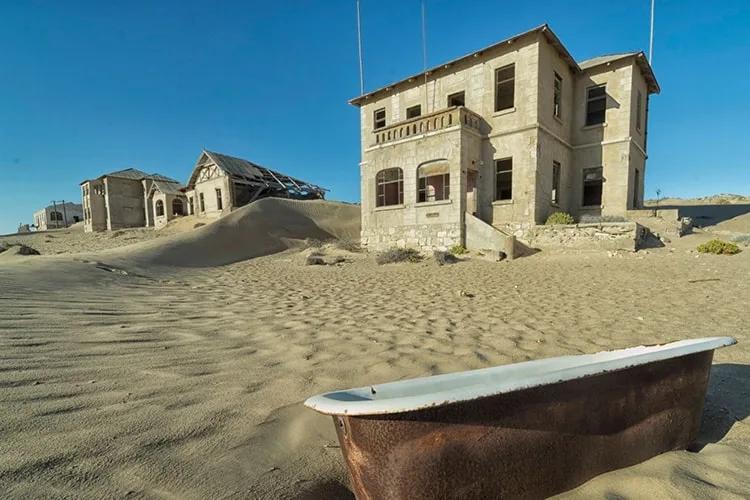
Traveling to our first ghost town on the list, there is a town in the Namib Desert known as Kolmanskop that is just miles away from the Nambia port town of Luderitz that has been uninhabited for the last 62 years.
Translated into English as “Coleman’s Hill,” Kolmanskop was named after Johnny Coleman, a transport driver who abandoned his ox wagon to hide in the area during a sand storm.
By the early 1900s, Kolmanskop had become a prosperous diamond mining village but not even early wealth could keep the town alive.
As German diamond miners flocked to the area, residents built a railroad station, casino, school, theater and hospital to support their growing village.
However, by the end of the first World War, the diamond resources had long been tapped out leaving many to pack up and move.
By 1954, no one was left in Kolmanskop as the desert quickly reclaimed the city filling the abandoned buildings with sand stretching nearly five feet high.
Today, the only signs of life that remain are tourists who are curious and brave enough to take a peek at this sandy ghost town.
Abandoned Places #13 – North Brother Island, New York
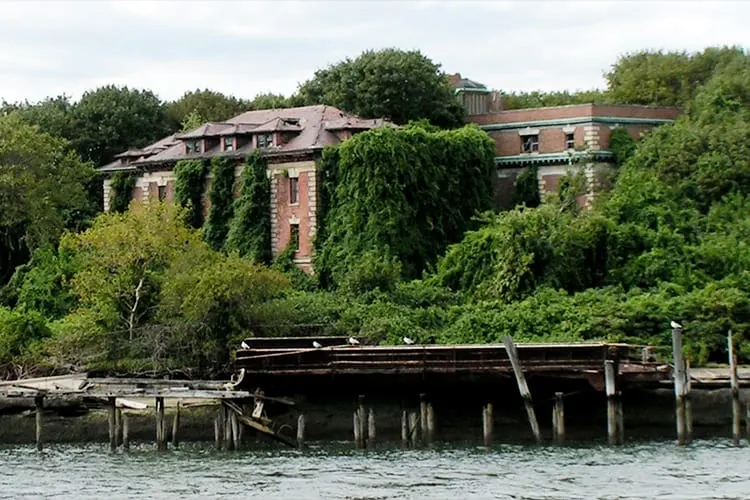
Making our first stop in the United States, on the East River in New York City nestled between the Bronx and Rikers Island sits a pair of islands better known as North and South Brother Islands.
Discovered in 1615 by the Dutch West India Company, the islands weren’t settled until the 1800s when a hospital was built on North Brother Island.
Afterward, the island became famous for housing “Typhoid Mary” Mallon until 1938 when the hospital was first shut down.
After the second World War, the 20-acre North Brother Island was used to house veterans but, once the housing shortage was settled, the facilities were abandoned until years later when they were reopened and used to treat drug addicts.
Closed in the 1960s amid rumors of staff corruption and the unethical treatment of patients, the facilities and North Brother Island were abandoned and have since been transformed into a bird sanctuary that is off-limits to the public.
#12 – Maunsell Sea Forts (England, United Kingdom)

Perhaps the most epic forts in the entire world (and with an incredible view!
), the Maunsell Sea Forts are armed towers that were built during World War II in the Thames and Mersey estuaries.
Heavily armed and used by both the Army and Navy to help defend the United Kingdom, the Sea Forts allowed soldiers to report any incoming German air raids as well as spot and shoot down enemy planes flying overhead.
When World War II came to an end, there was little need for the Maunsell Sea Forts and, by the late 1950s, they were decommissioned from use altogether.
After they sat unused for years, they were repurposed in the 1960s for pirate radio broadcasting.
While many of the Sea Forts have been deemed unsafe, closed or destroyed altogether, some of the structures like the Rough Sands and the Shivering Sands Forts are still fully operating and open to the public.
Abandoned Places 11 – NPO Energomash Rocket Factory (Khimki, Moscow)
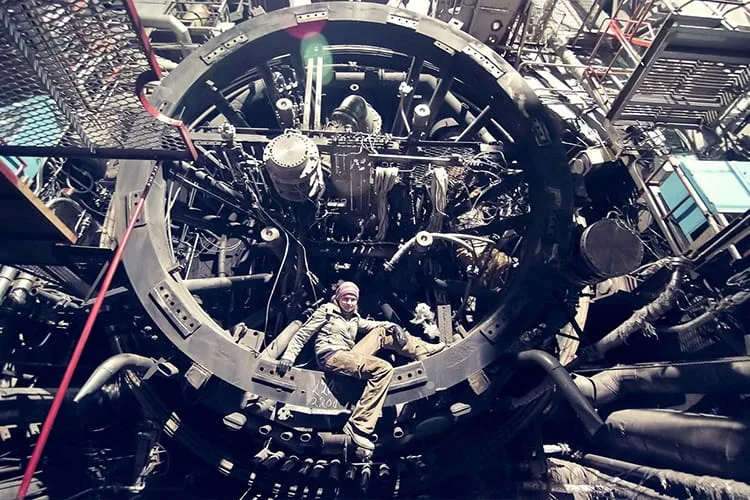
It doesn’t take a rocket scientist – or maybe it does! Known for its history in rocket engine development, NPO Energomash was established in 1946 and was led by Russian designer and engineer Valentin Petrovich “VP” Glushko.
At the height of the company’s history, NPO developed weapons during the Cold War but has since tapered its production after being bought and run by the Russian government.
Headquartered in Khimki, Moscow with nearly 6,000 employees and facilities in neighboring towns of Samara, Perm and St.
Petersburg, many of NPO’s early buildings have long been abandoned. One of the larger buildings nestled in the Khimki Forest is haunting for even the bravest photographer, Lana Sator, who paid the area a visit only to say, “The building is very impressive with different aspects.
First…at night there is no soul.” How’s that for a real Russian style fright night?
Yikes!
#10 – Lawndale Theatre (Chicago, Illinois)

Making our way to the Windy City, Chicago residents were thrilled in 1926 when the city announced there would be a new theater in town located on Roosevelt Road and Crawford Avenue.
Named the Lawndale Theatre, the building was a sight to behold when it opened a year later with its cathedral-like exterior and seating for 2,200 people.
Despite its beauty, the theatre’s ownership changed hands over the years and was used for movies and stage productions until 1961 when a notorious Chicago gang leader was murdered on the main stairs.
Reopening in 1964 as a church, the theatre spent the next 40 years filled with sermons and praise music until it shut down once again at the beginning of the new millennium.
Though there were rumors of reopening, the theatre remained untouched with its center stained glass window still showing bullet holes from the gangster’s death.
With debris covering the floor and the stage collapsing, the Lawndale Theatre was finally demolished in the summer of 2014.
#9 – Wonderland Amusement Park (Beijing, China)

Located just 20 miles outside of Beijing, China once sat the saddest amusement park in the world.
Intending to build Asia’s largest amusement park spanning 120 acres, Thailand’s Reignwood Group had good intentions but not enough funding when construction of Wonderland completely stopped in 1998 leaving its main castle and dozens of other buildings abandoned and unfinished.
A decade after the park’s construction stopped, there were high hopes that Wonderland would be finished but nothing ever happened.
Instead, the land was eventually reclaimed by local farmers who used the freshly tilled soil from non-existent roller coasters and water slides to plant their crops.
Now, after the last of the abandoned structures was demolished in May 2013, there is no hope for the park to ever be finished leaving many to wonder what might be built in its place.
Abandoned Places #8 – Craco, Italy
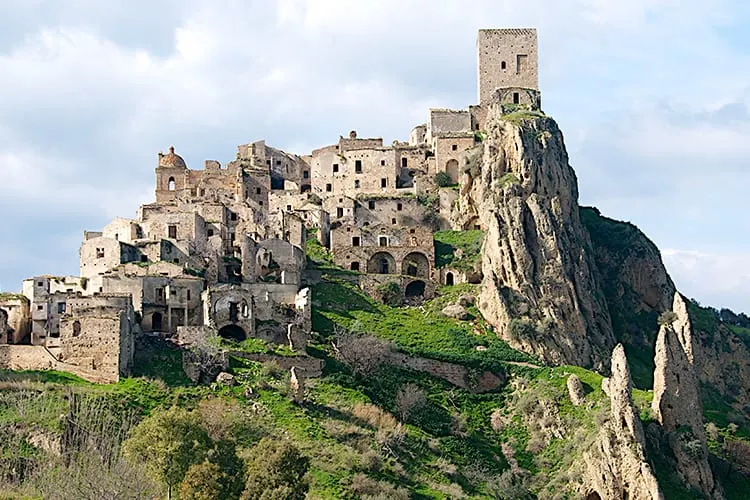
The hills are alive…with ghosts! The second ghost town on our list takes us all the way to the hills of southern Italy in the little town of Craco.
Nearly 1,500 years ago, the Greeks began construction on what was once known as Montedoro.
By the 1100s, the town was taken over by Roberto de Pietrapertosa and a military base and prison were established with a college to follow in the next century.
Continuing to grow over the next few centuries, Craco was a very large city in the 1800s but an economic downturn in the early 1900s led many residents to leave the area.
A little more than 50 years ago, a landslide caused by the city’s poor infrastructure and sewer systems claimed the rest of the town that had already fallen on hard times due to poor crop production.
Despite plans to repopulate the area, a 1980 earthquake halted those plans leaving Craco a ghost town, tourist attraction and popular filming location.
#7 – Lee Plaza Hotel (Detroit, Michigan)
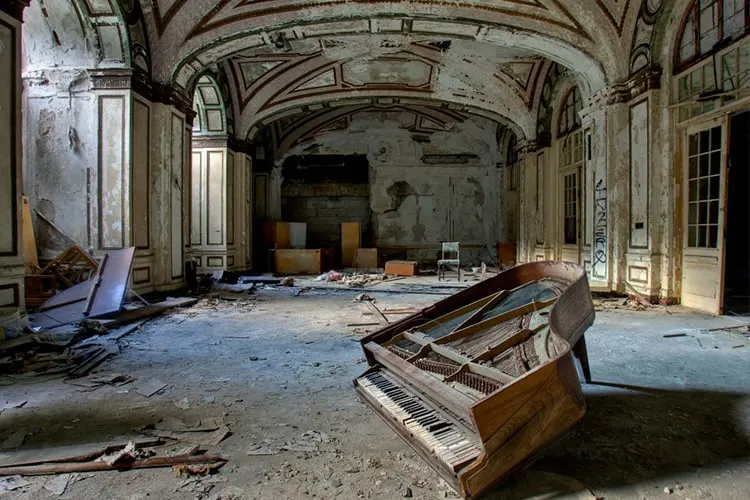
In a city that has seen more economic downfall than any other city in the United States, it’s no surprise that Detroit, Michigan has its fair share of abandoned buildings including the Lee Plaza Hotel.
Designed by Charles Noble and built in 1929 on West Grand Boulevard, the 15-story hotel was one of the swankiest places in Detroit with its stunning architecture that drew in visitors and residents from around the country.
By the 1980s, the Plaza’s glory days had long faded as it spent its final weeks of life as a senior citizen center before closing its doors in the 1990s.
Currently still abandoned, there is hope for Lee Plaza after developer Craig Sasser announced in November 2015 that he plans on purchasing the Plaza for $258,000 and then investing around $200 million in redeveloping the hotel and surrounding area to include luxury apartments, single-family homes and commercial properties as part of a local revitalization over the next few years.
We can’t wait!
#6 – C-121 Lockheed Constellation Crash (Antarctica)
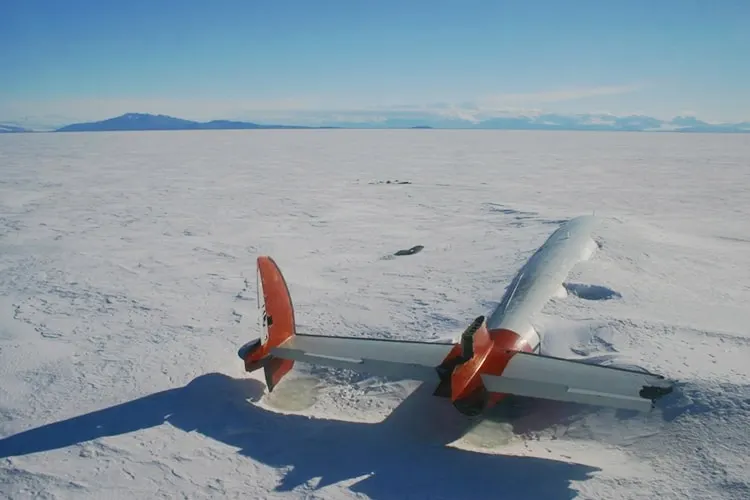
Traveling to the southernmost point of the Earth, Antarctica is home to a runway known as Pegasus Field located near the McMurdo Station.
Made out of blue ice that can be used by aircraft to land any time of year, the field was named after a C-121 Lockheed Constellation aircraft named “Pegasus” that crashed in whiteout conditions on October 8, 1970.
Thankfully, no one aboard the aircraft was injured.
Today, the “Pegasus” aircraft remains as a landmark for Pegasus Field after local officials had no other option but to leave the plane exactly where it landed.
As a result of quickly accumulating snow and arctic temperatures, removing the plane proved to be an expensive and almost impossible task.
Still sitting in the same place for the last 46 years, pilots and passengers flying in the area can see the white plane on fair weather days as a permanent part of arctic aviation history.
Abandoned Places #5 – Nara Dreamland (Nara, Japan)

The second Asian amusement park on our list, the Nara Dreamland theme park was once, unlike Beijing’s Wonderland, an incredibly popular destination.
Built in 1961 after Japan was inspired to create their own version of California’s Disneyland, the park had many features like its American counterpart including a Matterhorn style ride, a wooden roller coaster and a monorail that drew in visitors of all ages from around the country.
The park’s prosperity came to an end, however, when Disney announced plans to open the Tokyo Disney Resort in 1983.
As a result, the Nara Dreamland’s attendance levels plummeted until the park became permanently empty for months at a time.
By August 2006, the park owners realized they could never compete with the Disney name and closed the park doors forever.
Now sitting abandoned and rusty, the buildings and rides remain as an eerie setting for adventurous photographers and tourists brave enough to take a quick look at one of Japan’s earliest theme parks.
#4 – Christ of the Abyss (San Fruttuoso, Italy)

Under the sea! When it comes to statues, sculptors often want to proudly display their masterpieces (and for good reason) front and center for all the world to see.
This, however, wasn’t the case for Italian sculptor Guido Galletti and his Christ of the Abyss statue.
Spending four years on the piece, Galletti was inspired by Italian diver Duilio Marcante who did the unthinkable when he submerged the bronze statue of Jesus Christ off the San Fruttuoso Bay in the Mediterranean Sea as a tribute to Dario Gonzatti, his friend and fellow scuba diver.
Finished in 1954 and placed in the Bay by the Italian Navy and a team of skilled divers, the statue of Christ with his head and hands raised toward the surface has called the bottom of the sea home for over 50 years.
Having undergone restoration as a result of saltwater erosion, the statue has inspired numerous other sculptors and pieces with replicas around the world including Grenada (built in 1961) and Key Largo, Florida (built in 1962 and submerged in 1965).
Abandoned Places #3 – Pontiac Silverdome (Detroit, Michigan)
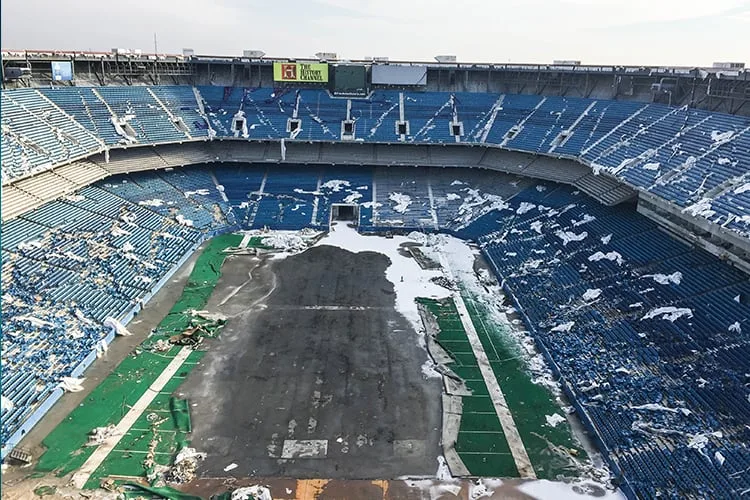
Heading back to Detroit, Michigan for the second time on our list, the Pontiac Silverdome was once the home of the Detroit Lions of NFL fame.
Long before moving downtown to Ford Field, the Lions would take the field on Sundays from 1975 until 2001 as 82,000 fans gathered together to cheer them to victory over popcorn, hotdogs and soda.
Since 2001, however, the Silverdome has gone mostly unused and is a far cry from its glory days when events like Wrestlemania III and Pope John Paul II’s visit broke historic attendance records.
Once the largest stadium in the NFL (until the 1997 opening of FedEx Field in Washington, D.
C). , the Silverdome was the first of its kind thanks to its iconic fiberglass fabric roof, which was removed in 2013.
Having been sold on multiple occasions and even reopened for several events over the last few years, the latest owners auctioned the stadium’s contents in 2014 with no plans for future development.
As of October 2015, news broke that the facility will be demolished in spring 2016 leaving local Detroit fans to say goodbye to a piece of local sport’s history.
#2 – Bodie, California
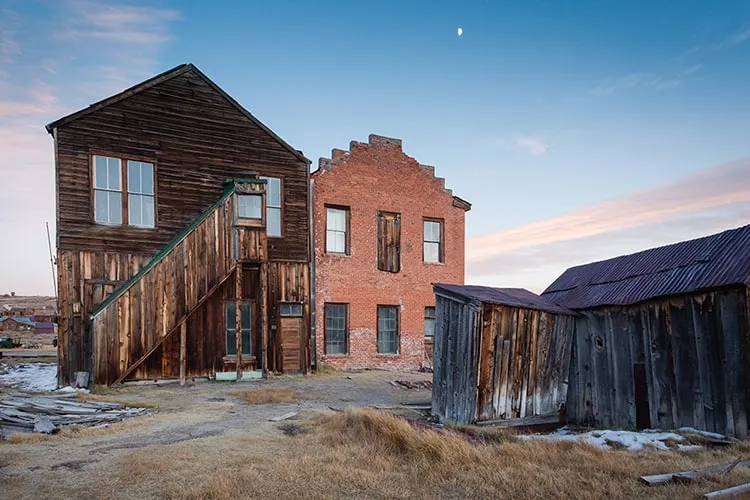
Let’s strike it rich! During the California gold rush in the 1800s, many rural areas quickly became bustling hubs of communities looking to strike it rich.
In 1859, gold was discovered in what would later become the town of Bodie, which was named after gold prospector W.
S. Bodey. Experiencing massive growth over the next 20 years as more gold and silver was found, the little town of Bodie saw its population swell to nearly 7,000 residents.
By 1880, Bodie was one of the largest cities in California which only made its demise even worse.
Once the gold started to dry out, Bodie residents packed up and made their way to Montana, Arizona and Utah with the hopes of finding better luck.
Once 1910 rolled around, the population had dropped dramatically and, by the start of World War II, less than 100 people remained.
Today, the ghost town is known as Bodie State Historic Park and is registered as a California Historical Landmark that attracts around 200,000 visitors each year.
Abandoned Places #1 – Pripyat, Ukraine
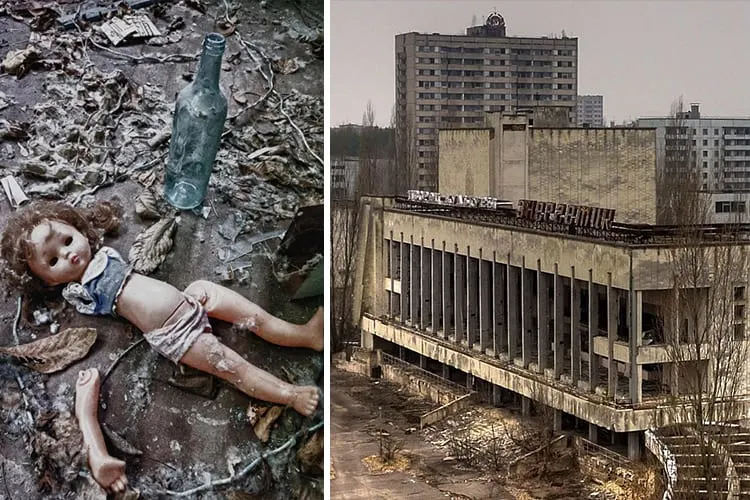
From a bustling hub to an abandoned ghost town in a matter of 30 years, it took something truly disastrous for the 50,000 residents of Pripyat, Ukraine to abandon their homes and start over.
Founded in 1970 as the town serving the Chernobyl Nuclear Power Plant, Pripyat was officially declared a city in 1979 and, just seven years later, became the site of catastrophe when the Chernobyl nuclear explosion killed 31 people and made the area completely uninhabitable.
The worst nuclear power plant accident in history, Chernobyl destroyed the town of Pripyat as residents were quickly evacuated from their homes.
With threats of cancer and high radiation levels, the Pripyat community never looked back as the iconic Ferris Wheel of the Pripyat amusement park, hospitals, schools, gyms and other building throughout the town were left abandoned.
Today, almost 30 years after the accident, people are still discouraged from visiting the nuclear ghost town but that hasn’t stopped some from wearing protective gear and snapping a few photos before heading to safer ground.
